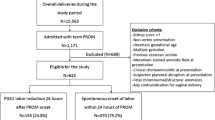Abstract
Objective: To compare the outcomes of expectant versus induction of labor management of patients presenting with prelabor rupture of membranes (PROM) at term. Study design: Observational case–control study over a period of 36 months. Setting: King Abdulaziz University Hospital, Jeddah, Saudi Arabia. Subjects: All obstetric patients with no obstetric risk factors, other than PROMs at term, were included in our study. Each patient was matched with a control case, whose labor started with intact membranes. Outcome measures: Length of labor duration, fetal distress, intrapartum pyrexia, rate of cesarean delivery, and Apgar scores at birth. Results: The length of labor duration was shorter in patients with PROMs at term compared to the control group, but the difference was not statistically significant. Furthermore, cesarean section (CS) rate was 4.5% in the PROMs group versus 5.5% in the control group. Among patients with PROM who received induction of labor management, the rates of intrapartum pyrexia and CS were almost twice than in patients who were managed expectantly. However, the differences were not statistically significant. Conclusion: In the absence of other obstetric and maternal or fetal risk factors, PROMs at term does not seem to constitute additional obstetric risks. Furthermore, expectant management of PROM at term enhances the patient’s chance of normal vaginal delivery without an increase in fetal and/or maternal morbidity.
Similar content being viewed by others
References
British Medical Journal (1979) Premature rupture of the membranes. Br Med J 1165–1166
Lanier LR, Scarbrough RW, Fillingim DW et al (1965) Incidence of maternal and fetal complications associated with rupture of the membranes before onset of labour. J Obstet Gynecol 93:398
Marshall VA (1993) Management of premature rupture of membranes at or near term. J Nurse Midwifery 38(3):140–145
Tamsen L, Lyrenas S, Enattingius S et al (1990) Premature rupture of the membranes intervention or not. Gynecol Obstet Invest 29(2):128–131
Russel KP, Anderson GW (1962) The aggressive management of ruptured membranes. Am J Obstet Gynecol 83:930–934
Duff P, Huff RW, Gibbs RS (1984) Management of premature rupture of membranes and unfavorable cervix in terms of pregnancy. Obstet Gynecol 63:697
Wagner MV, Chin VP, Peters CJ et al (1989) A comparison of early and delay induction of labour with spontaneous rupture of membranes at term. Obstet Gynecol 74:93
Kappy KA, Centralo C, Knuppel RA et al (1982) Premature rupture of membranes at term A comparison of induced and spontaneous labour. Reprod Med 27:29
Evaldson G, Lagrelius A, Winiarski J (1980) Premature rupture of the membranes. Acta Obstet Gynecol Scand 59:385
Egan D, Oherlihy C (1988) Expectant management of spontaneous rupture of membranes at term. J Obstet Gynecol 243–247
Bishop EH (1964) Pelvic scoring for elective induction. Obstet Gynecol 24:266–268
Seitchik J, Castillo M (1982) Oxytocin augmentation of dysfunctional labor. Clinical data Am J Obstet Gynecol 144:899
Grant J, Keirse MJ (1989) Prelabor rupture of membranes at term. In: Chalmers I, Enkin M (eds) Effective care in pregnancy and childbirth. Oxford University Press, New York, pp 1112
Minkoff H, Grunebamm A, Schawrz R et al (1983) Risk factors for prematurity and premature rupture of membranes: a prospective study of the vaginal flora in pregnancy. Am J Obstet Gynecol 150:965
Richard L, Naeye et al (1982) Factors that predispose to rupture of the fetal Membranes. Obstet Gynecol 60:93
Cammu H, Verlaenen H, Derde MP et al (1990) Premature rupture of membranes at term in nulliparous women: a hazard. Obstet Gynecol 76(4):671–674
Norman H, Daikoku D, Frank K et al (1981) Premature rupture of membranes and preterm labor: neonatal infection and perinatal mortality risks. Obstet Gynecol 58:417
Alcalay M, Hourvitz A, Reichman B (1996) Prelabor rupture of membranes at term: early induction of labor versus expectant management. Eur J Obstet Gynecol Reprod Biol 70(2):129–133
Hannah ME, Ohlsson A, Farine D et al (1996) Induction of labor compared with expectant management for prelabor rupture of membranes at term. N Engl J Med 334:1005–1010
Shalev E, Peleg D, Eliyahu S, Nahum Z (1995) Comparison of 12- and 72-hour expectant management of premature rupture of membranes in term pregnancies. Obstet Gynecol 85:766–768
Gafani A, Goeree R et al (1997) Induction of labor versus expectant management for prelabor rupture of membranes at term: an economic evaluation. Can Med Assoc J (11)1519–1525
Flenady V, King J, Review Group (2002) Cochrane pregnancy and childbirth group. Antibiotics for prelabor rupture of membranes at or near term. Cochrane Database System Rev AN:CD001807
Centers for disease control and prevention (2002) Prevention of perinatal group B Streptococcal disease: revised guidelines from CDC. MMWR 51:RR-11:1–28
Seaward PG, Hannah ME, Myhr TL, Farine D, Ohlsson A, Wang EE et al (1997) International multicenter term prelabor rupture of membranes study: evaluation of predictors of clinical chorioamnionitis and postpartum fever in patients with prelabor rupture of membranes at term. Am J Obstet Gynecol 177:1024–1029
Monga M, Oshiro BT (1993) Puerperal infections. Semin Perinatol 17:426–431
Shutte MF, Treffers, Kloosterman GJ et al (1983) Management of premature rupture of membranes: the risk of vaginal examination to the infant. Am J Obstet Gynecol 146:395
Author information
Authors and Affiliations
Corresponding author
Rights and permissions
About this article
Cite this article
Zamzami, T.Y.Y. Prelabor rupture of membranes at term in low-risk women: induce or wait?. Arch Gynecol Obstet 273, 278–282 (2006). https://doi.org/10.1007/s00404-005-0072-4
Received:
Accepted:
Published:
Issue Date:
DOI: https://doi.org/10.1007/s00404-005-0072-4




